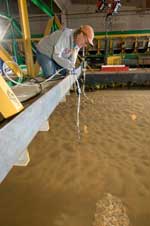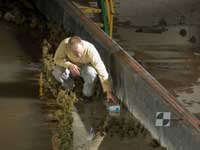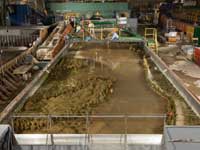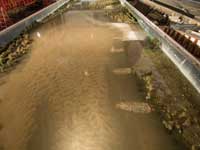Civil Engineers Scale Sacramento River to Solve Problems
 |
A downstream-migrating gravel bar threatens to compromise the recently constructed M&T-Llano Seco pump intake and fish screens located on the banks of the Sacramento River near the mouth of Big Chico Creek in northern California. If left unattended, the downstream movement of the gravel bar and consequent sedimentation issues will result in the loss of about 150 cfs of water used to irrigate rice and orchards on the M&T and Llano Seco ranches, as well as to supply water to dedicated wetlands and State of California wildlife refuges. Scientists at Colorado State University's Engineering Research Center are modeling plausible hydraulic scenarios and solutions to solve the river meandering problems on this stretch of river.
A collaboration between industry and academia, the project originated with Colorado State University alumni Drs. Bob Mussetter and Mike Harvey of Mussetter Engineering, Inc. MEI is a Fort Collins firm that provides consulting services in water resources engineering, fluvial geomorphology, engineering geomorphology and environmental hydraulics. MEI originally collected field data and conducted geomorphic and 1-D and 2-D modeling analyses of the M&T reach of the Sacramento River for this CALFED-funded project that is being managed by Ducks Unlimited, before coming to civil engineers at CSU for their expertise in physical modeling.
Challenged to explore the complexities of the river meandering, the team is determining the causes and future effects of bank erosion through innovative modeling. Project leader and civil engineering graduate student Sean Kimbrel, working under the direction of the project adviser, Dr. Chris Thornton, developed a 1/75 scale physical model of approximately 7500 feet of the river. Kimbrel and several undergraduate students created the 100-foot model from aerial photography, plan-view satellite images, GPS surveys, and bathymetric surveys of the river using a geogrid of cross-sections made from plywood and soil cement.
 Project leader Sean Kimbrel with the M&T-Llano Seco pump station |

1/75 scale physical model of 7500 feet of the Sacramento River
| 
Spur dikes redirect flow away from eroding bank |
The Colorado State researchers have determined that over time, with the gravel bar continually developing and depositing sediment, the river channel has eroded the bank opposite the pump station and significantly increased the width of the river. This creates positive feedback for the gravel bar to continually develop and progress towards the pump station.
In the next few months, researchers will be investigating several alternatives for modifying the current hydraulic processes affecting the river. Currently, analysis of scaling of the sediment size and flow properties, which includes the depth and velocities of the reach, are underway. In the next phase of the project, scientists will examine the current state of the river and what its future without human intervention holds, in efforts to determine if the gravel bar will further develop and move downstream over the pump intake.
"This research will aid in developing modeling techniques while at the same time producing unique solutions to a problem," said Kimbrel.
Researchers will also assess the use of spur dikes -- rock structures integrated into the bank that protrude into the river-- to redirect flow away from the eroding bank and towards the pump inlets and fish screens. A final model will test whether dredging a channel from the Sacramento River into nearby Big Chico Creek through the upstream gravel bar will increase the amount of flow and the required flow velocities at the fish screens.
In addition, an oversight committee including Ducks Unlimited, Mussetter Engineering, Inc., local property owners, the California Department of Fish and Game, the University of California-Davis, Stillwater Sciences and MWH Americas will evaluate the results of the CSU modeling and use them to develop engineering solutions to ensure the future supply of water while minimizing ecosystem impacts.
Chosen for its excellent facilities and expert personnel, the Engineering Research Center at Colorado State University provides unique opportunities to students for hands-on, real-world experience, adding purpose and application to textbook theory.